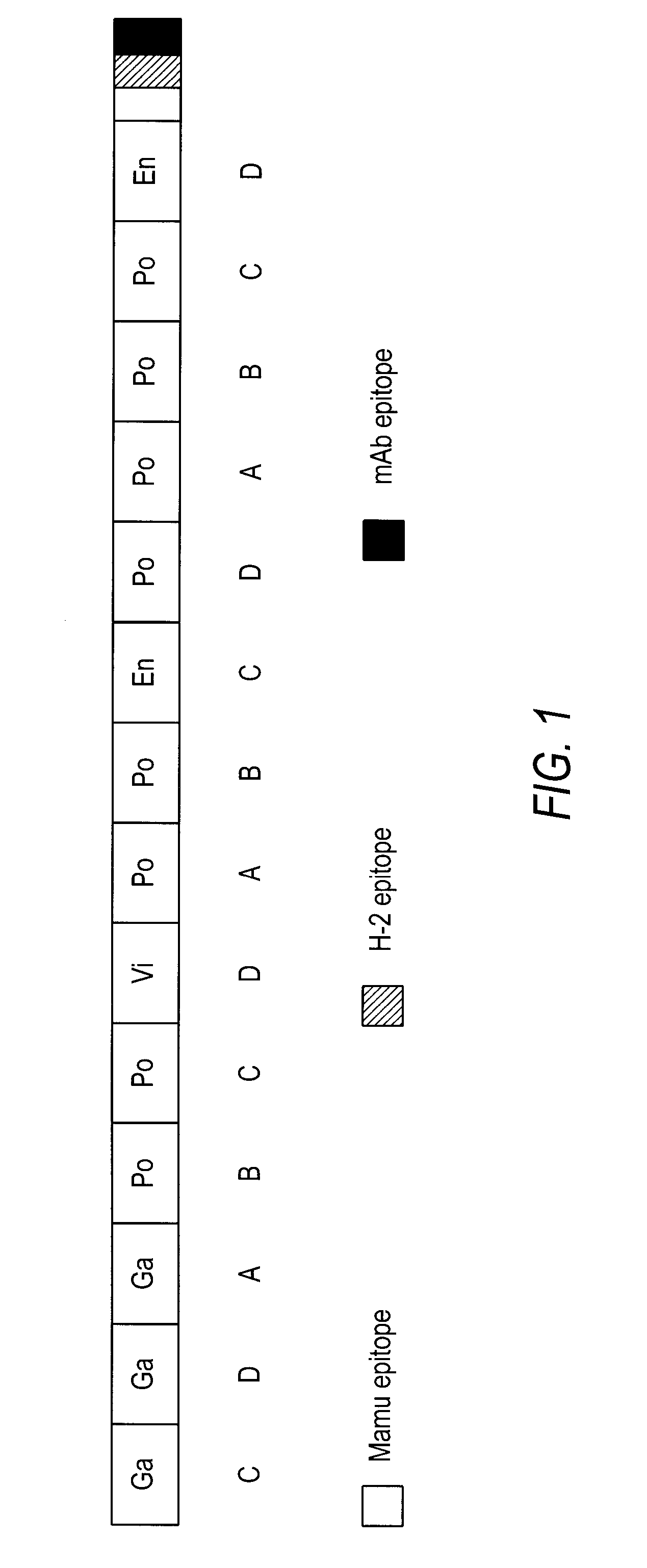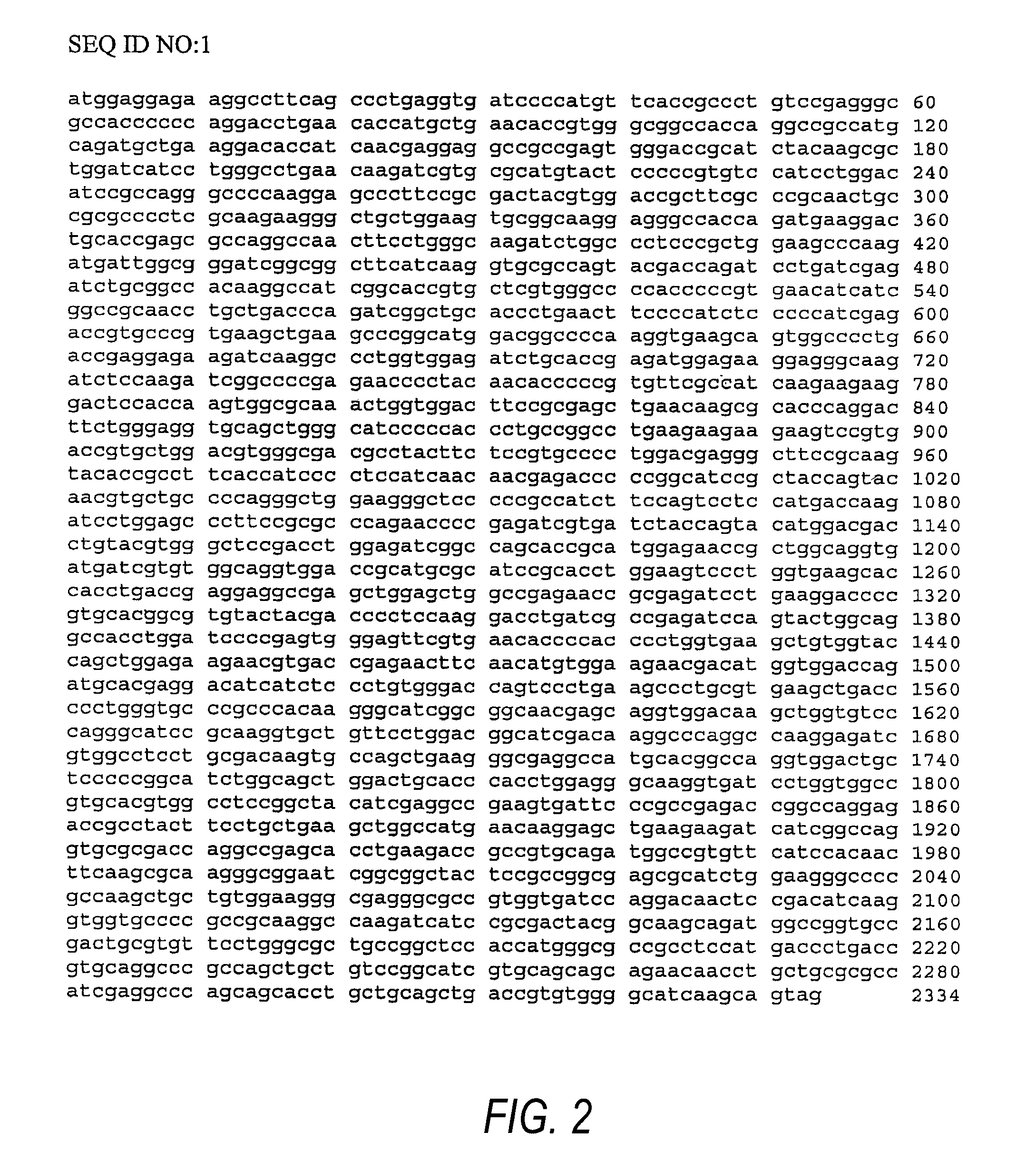Hivcon: an HIV immunogen and uses thereof
- Summary
- Abstract
- Description
- Claims
- Application Information
AI Technical Summary
Benefits of technology
Problems solved by technology
Method used
Image
Examples
example 1
HIVCON Plasmid Construction
[0185] The HIVCON ORF (see SEQ ID NO: 1, FIG. 2, and SEQ ID NO: 5, FIG. 6) was designed to encode a chimeric protein derived from the highly conserved domains of HIV proteins. HIVCON chimeric protein contains the 14 most conserved protein domains of HIV with the domains having less than 6% variability between four major HIV Clades A-D. The HIVCON ORF is contained within the HIVCON gene fragment, which also can include the Mamu-A*01 (SIV Gag p27) epitope, the murine P18-I10 (H-2K) epitope and the mAb epitope Pk. The HIVCON gene fragment was synthesized (geneART GmbH, Germany) using preferred human amino acid codon usage (Andre, S. et al (1998) J. Virol. 72(2): 1497-1503). The HIVCON ORF is preceded by a 12-nucleotide consensus Kozak sequence (Kozak, (1987) Nucleic Acid Res. 15:8125-8148) (see SEQ ID NO: 5, FIG. 6). The nucleotide sequences encoding the 14 conserved HIV protein domains were directly fused to each other with the Mamu-A*01 epitope, P18-I10 ep...
example 2
Preparation of MVA.HIVCON and MVA.HIVCONΔH
[0188] The HIVCON fragment is excised out of pTHr.HIVCON using XmaI and ligated into the XmaI site of transfer vector pSC11 (Chakrabarti) to produce the vector pSC11.HIVCON used in the preparation of recombinant MVA.HIVCON. The plasmid pSC11.HIVCON carries the β-galactosidase gene.
[0189] The HIVCONΔH fragment fragment is cut out of pTHr.HIVCONΔH using XmaI and ligated into the XmaI site of transfer vector pSC11 (Chakrabarti) to produce the vector pSC11.HIVCONΔH used in the preparation of recombinant MVA.HIVCONΔH. The plasmid pSC11.HIVCONΔH carries the β-galactosidase gene.
[0190] The HIVCON- or HIVCONΔH-coding fragment is inserted into the thymidine kinase locus of the virus genome under the p7.5 early / late vaccinia promoter using plasmid pSC11, which co-delivers a β-galactosidase gene to facilitate screening, titration and stability studies of the recombinant MVA.HIVCON or MVA.HIVCONΔH (Chakrabarti). This marker enzyme is commonly express...
example 3
HIVCON and HIVCONΔH Expression in Human Cells
[0192] HIVCON and HIVCONΔH expression was assessed in human 293T cells or HEK 293 cells transiently transfected with pTH.HIVCON or pTH.HIVCONΔH. HIVCON and HIVCOΔdH expression was assessed in human 293T cell infected with MVA.HIVCON or MVA.HIVCONΔH at an MOI of 5.
[0193] For immunofluorescence studies, six-well plates containing sterile slides pre-treated with poly-L-lysine (70,000-150,000 molecular mass; Sigma) were seeded with 293T cells (2×105 cells per slide). Twenty four hours later, the cell monolayers were transfected with either pTH.HIVCON or pTH.HIVCONΔH. To monitor the expression from the MVA constructs, the cell monolayers are infected with MVA.HIVCON or MVA.HIVCONΔH at an MOI of 5. After a 24-hour incubation at 37° C. with 5% CO2, the cells were washed and their membranes were perforated. The slides were blocked with 2% FCS in phosphate-buffered saline (PBS) at 4° C. for 1 hour and incubated with a 1:200 dilution of the desig...
PUM
| Property | Measurement | Unit |
|---|---|---|
| Fraction | aaaaa | aaaaa |
| Fraction | aaaaa | aaaaa |
| Immunogenicity | aaaaa | aaaaa |
Abstract
Description
Claims
Application Information
 Login to View More
Login to View More - R&D
- Intellectual Property
- Life Sciences
- Materials
- Tech Scout
- Unparalleled Data Quality
- Higher Quality Content
- 60% Fewer Hallucinations
Browse by: Latest US Patents, China's latest patents, Technical Efficacy Thesaurus, Application Domain, Technology Topic, Popular Technical Reports.
© 2025 PatSnap. All rights reserved.Legal|Privacy policy|Modern Slavery Act Transparency Statement|Sitemap|About US| Contact US: help@patsnap.com



